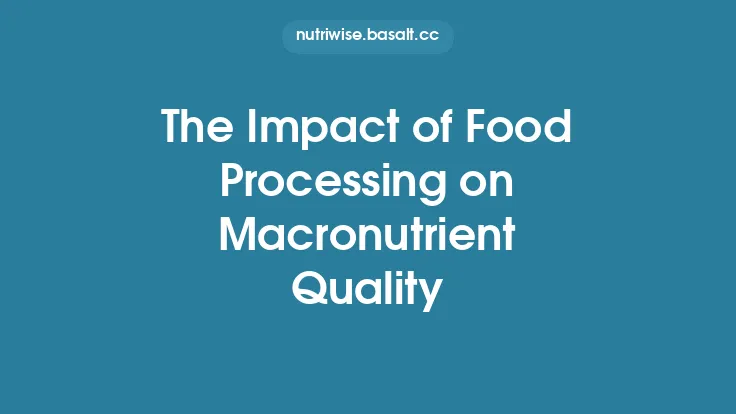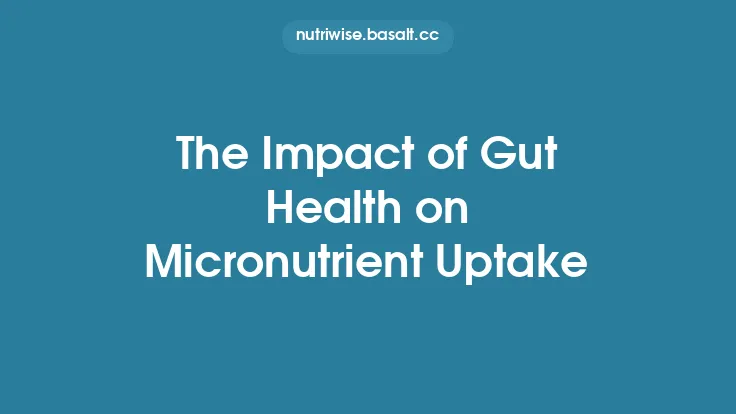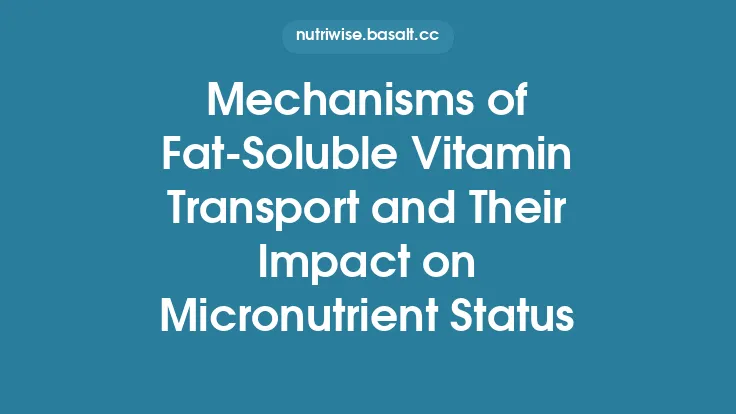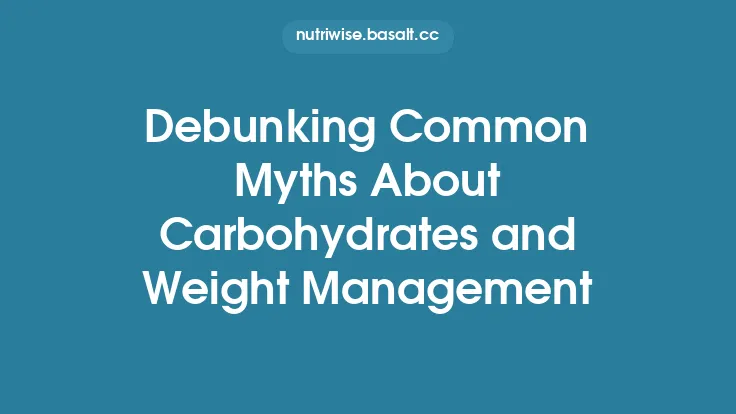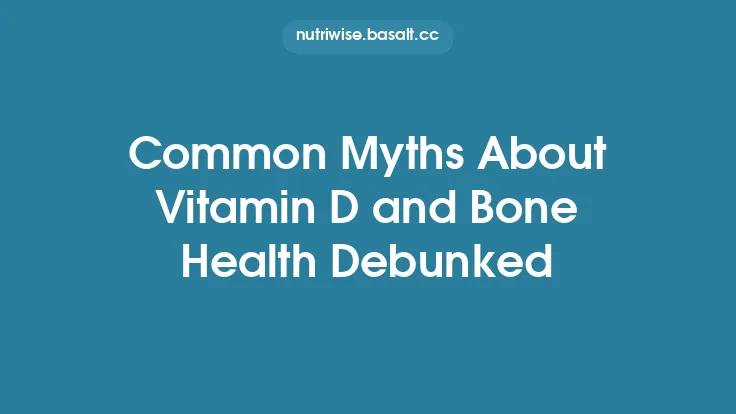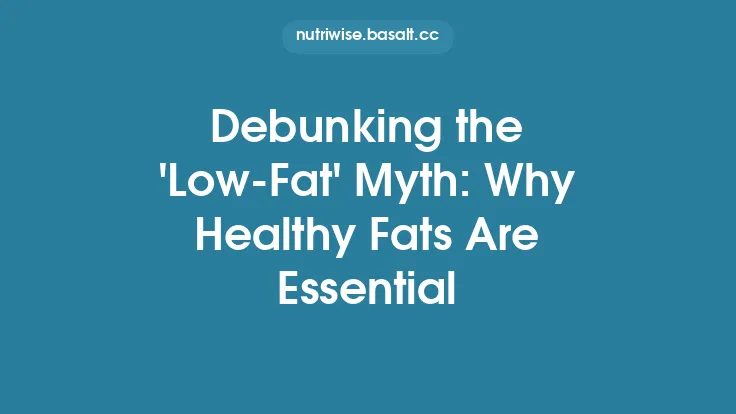When it comes to heart health, the conversation around dietary fat has long been dominated by oversimplified slogans—“cut the fat,” “avoid saturated,” “choose low‑fat.” While reducing excess calories is undeniably important, the quality of the fat you consume plays a far more nuanced role in cardiovascular risk than the blanket advice found in many popular diet plans. Understanding how different fat qualities interact with the body’s metabolic pathways, inflammatory processes, and vascular function can help you separate fact from fiction and make evidence‑based choices that truly support a healthy heart.
Why Fat Quality Matters More Than Quantity Alone
The human body requires fat for essential functions: it provides a dense source of energy, serves as a building block for cell membranes, and carries fat‑soluble vitamins (A, D, E, K). However, not all fats are created equal in the way they influence cardiovascular health. Two primary dimensions define fat quality:
- Structural Integrity – Whether the fat is intact, minimally processed, and free from harmful chemical alterations (e.g., trans‑isomerization, oxidation).
- Food Matrix Context – The surrounding nutrients and fiber in the whole food that accompany the fat, which can modulate absorption, metabolism, and downstream effects on blood lipids.
When fats are extracted, refined, or chemically altered, they often lose protective compounds (phytochemicals, antioxidants) and may acquire harmful ones (trans fats, oxidized lipids). Conversely, fats embedded in whole foods such as nuts, seeds, avocados, and fatty fish retain a complex matrix that can blunt adverse lipid changes and even promote beneficial ones.
Myth 1: “All Saturated Fat Is Bad for the Heart”
The reality: Saturated fatty acids (SFAs) are a heterogeneous group. Some, like stearic acid (found in cocoa butter and certain nuts), have a neutral effect on LDL‑cholesterol, while others, such as lauric acid (in coconut oil), raise both LDL and HDL cholesterol. The net impact on cardiovascular risk depends on the food source and accompanying nutrients.
- Whole‑food context matters. When saturated fat comes from minimally processed dairy (e.g., full‑fat yogurt) or dark chocolate, epidemiological studies often show no increase—or even a modest decrease—in heart disease risk. This is thought to be due to the presence of calcium, magnesium, and bioactive compounds that counterbalance any lipid‑raising effect.
- Refined, isolated saturated fats (e.g., butterfat added to processed snacks) lack these protective companions and are more likely to contribute to an unfavorable lipid profile.
Thus, the blanket condemnation of saturated fat ignores the critical role of food matrix and processing.
Myth 2: “Low‑Fat Diets Are the Safest Path to a Healthy Heart”
The reality: Low‑fat diets can inadvertently increase cardiovascular risk when they replace fat with refined carbohydrates and added sugars. This substitution often leads to:
- Elevated triglycerides and small, dense LDL particles, both of which are strong predictors of atherosclerosis.
- Insulin resistance due to high glycemic load, which promotes endothelial dysfunction and inflammation.
Randomized controlled trials comparing low‑fat, high‑carbohydrate diets to moderate‑fat, whole‑food‑based diets consistently show that the latter produce more favorable changes in blood lipids, blood pressure, and inflammatory markers. The key is not merely reducing fat, but ensuring that the fats you do consume are of high quality.
Myth 3: “Coconut Oil Is a Heart‑Healthy Miracle”
The reality: Coconut oil is high in medium‑chain saturated fatty acids, primarily lauric acid. While it raises HDL cholesterol, it also raises LDL cholesterol to a comparable degree. The net effect on the LDL/HDL ratio—a more reliable cardiovascular risk marker—is minimal. Moreover, most of the research on coconut oil involves short‑term feeding studies; long‑term data linking coconut oil consumption to reduced heart disease events are lacking.
When coconut oil replaces highly processed vegetable oils that contain trans fats or oxidized lipids, some short‑term improvements may be observed. However, substituting it for whole‑food sources of fat (e.g., nuts, seeds, fatty fish) does not confer additional heart‑protective benefits and may even be less advantageous.
Myth 4: “Trans Fats Are Only a Problem in Packaged Snacks”
The reality: While industrial trans fats are most notorious in processed foods, they can also form during high‑heat cooking of any oil, especially when the oil is repeatedly heated (deep‑frying, reheating). Even small amounts of trans fats can:
- Increase LDL cholesterol while simultaneously lowering HDL cholesterol.
- Promote systemic inflammation by altering cell membrane fluidity and signaling pathways.
- Accelerate endothelial dysfunction, a precursor to plaque formation.
Regulatory bans have dramatically reduced industrial trans fats in many countries, but hidden sources persist in restaurant fry oils and some baked goods. Choosing cooking methods that avoid repeated heating of the same oil and opting for fresh, minimally processed fats can mitigate inadvertent trans‑fat exposure.
The Science Behind Fat Quality and Cardiovascular Mechanisms
1. Lipid Profile Modulation
High‑quality fats tend to improve the lipid profile by:
- Increasing HDL cholesterol (the “good” cholesterol) through mechanisms that enhance reverse cholesterol transport.
- Lowering small, dense LDL particles, which are more atherogenic than larger LDL particles.
- Reducing triglyceride levels, especially when paired with dietary fiber and protein.
Conversely, low‑quality fats—particularly those that are oxidized or contain trans isomers—raise LDL cholesterol and triglycerides, fostering a pro‑atherogenic environment.
2. Inflammation and Oxidative Stress
Oxidized lipids act as danger signals that trigger inflammatory cascades in arterial walls. Whole‑food fats contain natural antioxidants (e.g., vitamin E, polyphenols) that protect lipids from oxidation during digestion and circulation. When fats are stripped of these antioxidants—through refining, bleaching, or high‑temperature processing—their propensity to oxidize increases, amplifying inflammation.
3. Endothelial Function
The endothelium (inner lining of blood vessels) regulates vasodilation, platelet aggregation, and leukocyte adhesion. High‑quality fats support endothelial nitric oxide production, promoting vasodilation and reducing blood pressure. In contrast, trans fats and oxidized lipids impair nitric oxide synthesis, leading to vasoconstriction and heightened blood pressure.
4. Plaque Stability
Atherosclerotic plaques become dangerous when they are thin‑capped and prone to rupture. Fat quality influences plaque composition:
- Anti‑inflammatory fats (e.g., those rich in monounsaturated fatty acids within whole foods) encourage a fibrous, stable plaque cap.
- Pro‑inflammatory fats (oxidized, trans) foster a lipid‑rich, necrotic core that is more likely to rupture, precipitating heart attacks or strokes.
Evidence From Large‑Scale Cohort Studies
- The Nurses’ Health Study (NHS) & Health Professionals Follow‑up Study (HPFS): Participants who consumed higher amounts of nuts and seeds (sources of minimally processed fat) exhibited a 20–30 % lower risk of coronary heart disease, independent of total fat intake.
- The EPIC (European Prospective Investigation into Cancer and Nutrition) cohort: Replacing 5 % of energy from refined carbohydrates with equivalent energy from high‑quality fats (e.g., olive oil, avocado) was associated with a 10 % reduction in cardiovascular mortality.
- The PURE (Prospective Urban Rural Epidemiology) study: Populations with higher intake of whole‑food fats (e.g., fish, nuts) had lower rates of major cardiovascular events, even when total fat consumption exceeded the traditional 30 % of calories recommendation.
These findings underscore that the *type and quality* of fat, rather than the absolute amount, drive cardiovascular outcomes.
Practical Strategies for Prioritizing Fat Quality
- Choose Whole‑Food Sources
- Nuts & Seeds: Almonds, walnuts, chia, and flaxseeds provide intact fats within a fiber‑rich matrix.
- Avocado: Delivers monounsaturated fat alongside potassium and antioxidants.
- Fatty Fish: Salmon, mackerel, and sardines supply high‑quality lipids with natural anti‑inflammatory compounds.
- Full‑Fat Dairy (when tolerated): Yogurt and cheese from grass‑fed animals contain beneficial fatty acids and calcium.
- Avoid Highly Refined Oils
- Oils that have been chemically extracted, bleached, and deodorized (e.g., many commercial vegetable oils) lack natural antioxidants and are more prone to oxidation. Opt for cold‑pressed, minimally processed oils if you need a liquid fat for dressings.
- Limit Repeated Heating of the Same Oil
- Reusing oil for deep‑frying creates trans‑fat and oxidized lipid by‑products. Use fresh oil for each cooking session or choose cooking methods that require little to no added fat (steaming, roasting with a light coating).
- Be Wary of “Fat‑Free” Processed Foods
- Many low‑fat products compensate with added sugars or refined starches, which can worsen lipid profiles and increase inflammation. Read ingredient lists for hidden carbs rather than focusing solely on fat content.
- Incorporate Fat‑Rich Plant Foods in Balanced Meals
- Pairing fats with fiber‑rich vegetables and lean protein improves satiety, blunts post‑prandial glucose spikes, and supports favorable lipid metabolism.
How to Evaluate Emerging Research
When encountering new studies on dietary fat and heart health, apply these critical lenses:
- Population vs. Intervention: Observational cohort data can reveal associations but cannot prove causation. Randomized controlled trials (RCTs) provide stronger evidence but often have shorter durations.
- Food Matrix Consideration: Does the study isolate a single fatty acid, or does it examine whole foods? Whole‑food studies are more reflective of real‑world eating patterns.
- Processing Level: Look for descriptions of how the fat was sourced—cold‑pressed, refined, hydrogenated, or naturally occurring.
- Outcome Measures: Prioritize studies that assess hard cardiovascular events (heart attacks, strokes) over surrogate markers (solely LDL levels) for a more accurate risk appraisal.
Bottom Line
Heart health is not a simple equation of “less fat = better heart.” The *quality* of the fat you consume—its structural integrity, processing level, and the food matrix that surrounds it—exerts profound influence on lipid profiles, inflammation, endothelial function, and ultimately, cardiovascular disease risk. By favoring minimally processed, whole‑food sources of fat and steering clear of refined, oxidized, or trans‑fat‑laden products, you can harness the protective power of dietary fat while debunking the myths that have clouded public understanding for decades.
